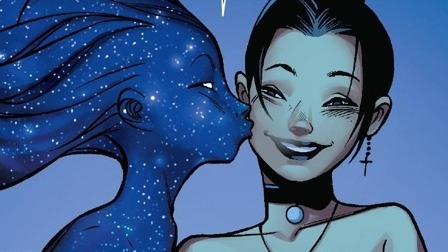also it’s been proven numerous times that physical punishment is the least effective form of discipline and that negative punishment (taking away privileges for example) is much more effective. like just because you grew up gettin beatings doesn’t mean you have to do the same to your kids be better than your parents that’s part of being a parent in the first place. to better not only yourself but provide a better life to your kids than you had.
Greetings and showing of respect in LOK and ATLA
The atla universe uses several traditional Asian greetings.
LOK: Bowing
Tarrlok bows when he enters Tenzin’s home; the clerk bows to Mako when he enters the shop.
Compare how deep the bow respectively. The deeper the bow the greater the difference in station.
Bows are the traditional greeting in East Asia, particularly in Japan, Korea, Taiwan, China, and Vietnam.
Basic bows originate at the waist and are performed with the back straight and the hands at the sides (for men) or clasped in front (for women), and with the eyes down. Generally, the longer and deeper the bow, the stronger the emotion or the greater the difference in social standing.
Bows can be generally divided into three main types: informal, formal, and very formal. Informal bows are made at about a fifteen degree angle and more formal bows at about thirty degrees. Very formal bows are deeper.
ATLA
The Fire Nation style greeting shown in the atla pictures above closely resembles the greeting known as Bao Quan 抱拳 i.e. the Chinese martial arts style greeting.
The way Azuala’s soldiers greet her on the ship is known as a kowtow i.e. a show of respect reserved for high officials, nobility, royalty and religious practice.
Neither Bao Quan nor Gong Shou are done in Japan. They are uniquely Chinese greetings.
Gong Shou is a common traditional practice of greeting among the chinese, notably during the traditional chinese festival such as Chinese New Year, marriage ceremony, between neighbours, friends, colleagues etc. It is polite way of representing respect, blessing and wishes. It is also practised when saying goodbye.To practise such greeting, the common way is to stand up with your upper body fully upright, extend your two elbows, then wrap your two hands/fists together as one in front of your chest (usually the left fist will be clenched, while the right palm will wrap the left fist). After wrapping the fist together, just shake the together up/down many times. (You will probably see this common practice in chinese kungfu movie or historical drama series). Gong Shou is usually accompanied by traditional chinese greeting words such as “Gong Xi Gong Xi 恭喜,恭喜” (Congratulations! Congratulations! ),”Jiu Yang Jiu Yang 久仰、久仰” (Long Time No See),”Qing Duo Duo Guan Zhao 请多多关照” (Please take good care) ,”Jie Ri Guai Le 节日快乐” (Happy Festival) ,”Hou Hui You Qi 后会有期” (see you later and in the future).
Martial Arts Greeting Bao Quan 抱拳
This is a common etiquette in Chinese Martial Arts. The etiquette is known “Bao Quan Li 抱拳礼” (literally translated as “Fist Wrapping Rite”. You will see this in Chinese Kungfu movie or in chinese martial arts sparring. The common practice is as follow: Stand Upright with the body straight. Clench your right fist. Straighten your left palm to have 4 fingers in plane, and your left thumb slightly bend. Wrap your two hands together (the left palm over the right clenched fist). Placed the two hands in front of your chest, but making sure that your two eldows do not come up. There are philosophical martial arts meaning about this practice: The left palm (with 4 fingers) symbolizes Virtue, Wisdom, Health, Art, which are also called the “4 nurturing elements”, symbolizing the spirit of Martial arts. The left thumb is slightly bent to mean that one should not be arrogant or always attempt to be no.1 . The right fist symbolizes rigorous practice. Since the right fist is clenched, it means a form of ‘attack’ but with the left palm wrapping it, it means “discipline” and ‘restraint/control in order not to abuse the martial practice”. Another explanation is that the left hand symbolizes the “5 lakes 五湖” while the right fist clenched symbolzies “4 sea 四海”). When the left hand is placed onto the right hand, it means that “people in the 5 lakes and 4 seas are all brothers” (五湖四海皆兄弟). It’s a practice to respect and prevent fightings among the different martial groups in the past.
Bowing (also known as “Ketou 磕头” or Kowtow)
Bowing was a form of ancient chinese practice when a commoner or an official greet an emperor. It was also practised when a commoner greet an official (such as magistrate or someone in the chinese bureaucracy). The common practice was to kneel down on the floor, and then bow with heads touching the ground and two hands landing on the floor. Such practice was largely abandoned after Chinese imperialism ended in 1911. Today, chinese rarely bow, although it can be quite common ‘knock the head’ as a form of slight bowing in greeting. Kowtoy (bowing) is only practised today in Chinese religious ceremony/rituals such as ancestor worship, daoist ceremony, buddhist paying homage to the Buddha etc. The 90 degree bowing is however practised in Japanese culture.
Rebloged for the anon that asked. Original - ATLA only - post is here.
Here’s another one from Korra!
I love seeing the connections.


